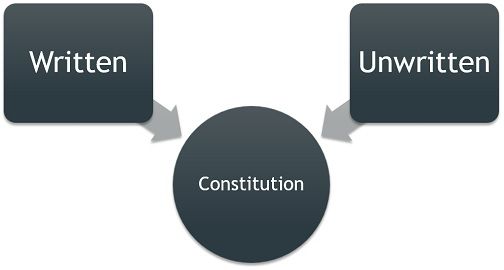
This blog compares written and unwritten constitutions, exploring their features, advantages, and limitations, with examples from India, the UK, and other nations.
Written vs. Unwritten Constitution
Introduction
A constitution is the fundamental law that sets out how a country is governed. It establishes the framework for political institutions, distributes power among them, and ensures citizens’ rights. Constitutions can be either written or unwritten, and understanding the distinction is essential for political science, comparative politics, and public administration.
1. What is a Written Constitution?
Definition:
A written constitution is a single, codified document or a collection of legal texts that systematically outlines the structure of the government, the distribution of powers, and the rights of citizens.
Key Features:
Codified in a formal document
Deliberately enacted by a constituent assembly or similar authority
Considered supreme law of the land
Can usually only be amended by a special process (not ordinary legislation)
Examples:
India (1950) – The longest written constitution in the world
United States (1789) – The oldest functioning written constitution
Germany – Basic Law of 1949
2. What is an Unwritten Constitution?
Definition:
An unwritten constitution is not contained in a single legal document. Instead, it consists of multiple sources like statutes, judicial decisions, conventions, and customs.
Key Features:
Not codified in one document
Evolves over time, based on traditions, practices, and judicial rulings
Often more flexible and adaptable
Relies heavily on precedents and conventions
Examples:
United Kingdom – The classic example
New Zealand
Israel (partially written, heavily reliant on statutes and customs)
3. Differences Between Written and Unwritten Constitutions
4. Merits and Demerits of Written Constitution
Merits:
Clarity and precision in governance
Protects fundamental rights more explicitly
Legal supremacy is clear
Offers a blueprint for all organs of the state
Demerits:
Often rigid, making changes slow
Might not adapt well to changing circumstances
Judicial interpretation can become too dominant
5. Merits and Demerits of Unwritten Constitution
Merits:
Flexibility and adaptability to changing political contexts
Evolves through democratic practices and traditions
Encourages organic growth of the political system
Demerits:
Lack of clarity can lead to misuse
Rights may not be clearly spelled out
Over-dependence on conventions may cause constitutional uncertainty
6. Which is Better?
It depends on the context and political culture of the country:
For newly independent or diverse nations, a written constitution offers structure and stability.
In stable democracies with a long legal tradition (like the UK), an unwritten constitution can work effectively.
India, due to its diversity and colonial legacy, chose a written constitution to ensure clarity, unity, and a strong foundation for democracy.
7. The Indian Constitution: A Case Study in Written Constitution
India’s Constitution is a classic example of a written constitution:
Drafted by a Constituent Assembly
Adopted in 1950
Contains 448 Articles, 12 Schedules, and numerous Amendments
Ensures fundamental rights, directive principles, and detailed governance structures
However, over time, conventions and judicial interpretations have also shaped its functioning, showing a blend of written and unwritten features.
8. The UK Constitution: A Case Study in Unwritten Constitution
The UK has:
No single codified document
A constitution based on:
Statutes (e.g., Magna Carta, Bill of Rights)
Judicial decisions
Conventions (e.g., Prime Minister must be from the majority party)
Flexibility allows quick reforms (like the Fixed-term Parliaments Act)
Despite being unwritten, it is one of the world’s most stable and effective constitutions.
Multiple Choice Questions (MCQs)
1. Which of the following countries has a written constitution?
A. United Kingdom
B. New Zealand
C. India
D. Israel
Answer: C. India
2. An unwritten constitution is primarily based on:
A. Judicial decisions only
B. A single legal document
C. Conventions, customs, and statutes
D. Religious texts
Answer: C. Conventions, customs, and statutes
3. Which of the following is a demerit of a written constitution?
A. Lack of legal clarity
B. Excessive rigidity
C. Inability to protect rights
D. Lack of legal supremacy
Answer: B. Excessive rigidity
4. The Indian Constitution can be classified as:
A. Entirely rigid
B. Entirely flexible
C. Rigid for federal provisions, flexible for others
D. Unwritten and uncodified
Answer: C. Rigid for federal provisions, flexible for others
5. Which of the following is NOT a feature of an unwritten constitution?
A. Evolved over time
B. Codified in a single document
C. Based on customs and traditions
D. Flexible
Answer: B. Codified in a single document
UPSC-Level Questions
1. [Mains – GS Paper 2]
"India’s constitution is not only a legal document but also a social contract. Discuss in light of its written and unwritten elements."
Hints to answer:
Written features: Articles, Fundamental Rights, Directive Principles
Unwritten elements: Conventions (e.g., PM as leader of majority), judicial doctrines (Basic Structure)
Social contract: It reflects aspirations and social justice vision
2. [Prelims – Objective]
Which one of the following pairs is correctly matched?
Answer: (d) New Zealand – Unwritten
3. [Mains – Essay Type]
“A constitution, whether written or unwritten, is only as effective as the political will that supports it.” Examine with examples from India and the UK.
Conclusion
Whether written or unwritten, a constitution reflects a nation’s political philosophy, history, and aspirations. While the written constitution offers structure and certainty, the unwritten constitution provides adaptability. The effectiveness of either system depends more on democratic values, judicial integrity, and public participation than on the format of the constitution itself.
11-Jul-2025 02:29 PM
Explore the fascinating structure, origin, and dynamics of our Earth—from...
11-Jul-2025 02:18 PM
Understand the vital role of lysosomes and cellular transmission in...
11-Jul-2025 01:48 PM
A concise and exam-focused overview of Plasmolysis and Protoplasm, covering...
04-Jul-2025 12:46 PM
India’s education system is undergoing a major transformation to prepare...
02-Jul-2025 02:51 PM
Recent research suggests that the transfer of genes between fungi...
Leave a Comment